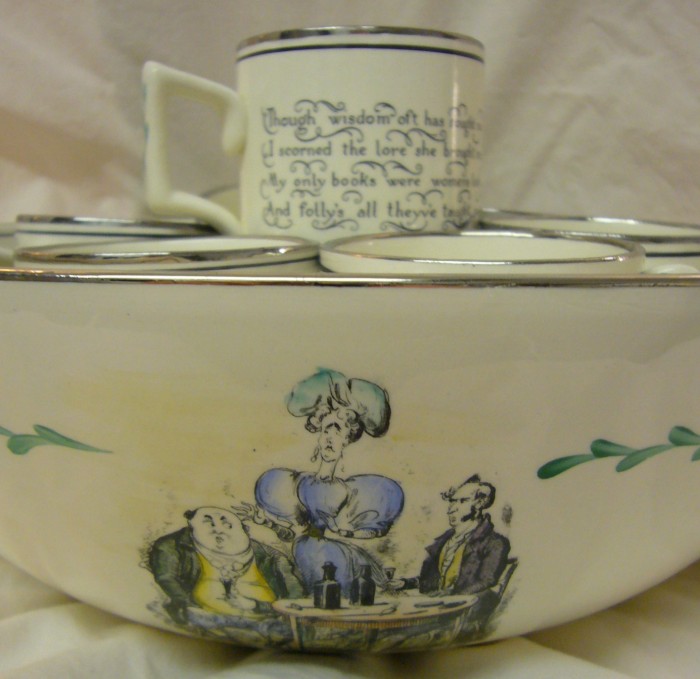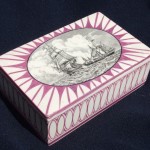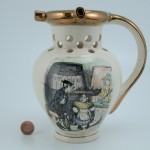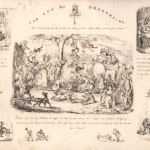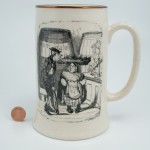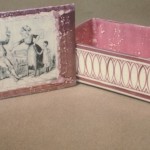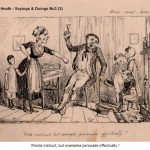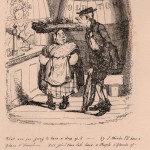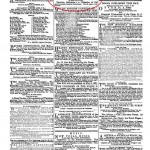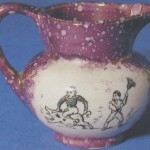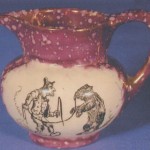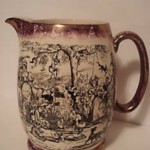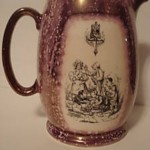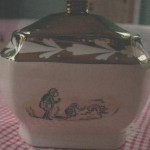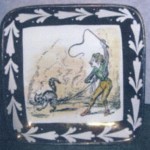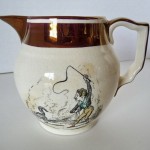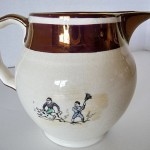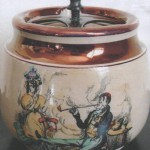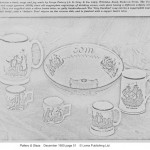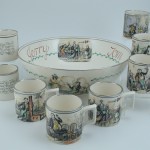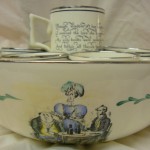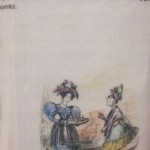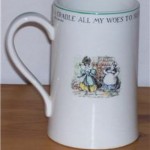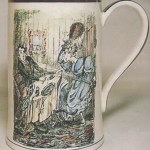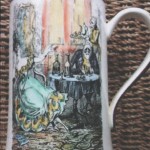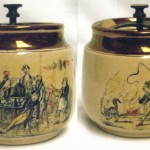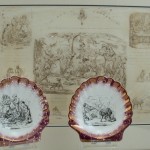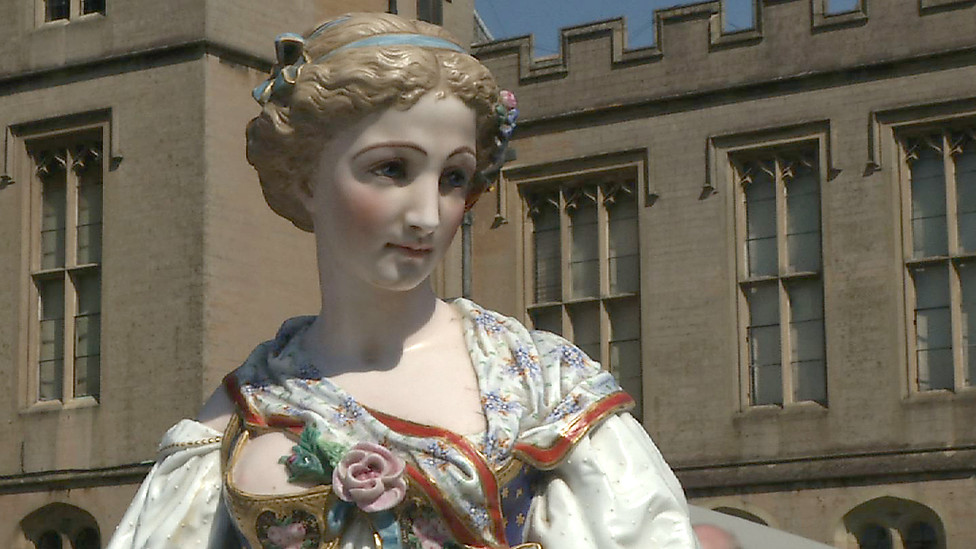- The interior of the box is pink splashed lustre.
- Extract from the 1831 London Literary Gazette – original in the Library of Princeton University, digitised by Google.
Henry Heath was a draughtsman, an etcher of political caricatures and a lithographer, who switched from etching to lithography in 1831 (information © Trustees of the British Museum). He worked as an engraver from about 1824-30. An advertisement in the London Literary Gazette of 1831 (No 742, April 9th, p237) publicises an offer from Charles Tilt of London: The Art of Tormenting; a series of Illustrations of the most approved Methods of excelling in this valuable acquisition: comprised in Forty-four Subjects. This series of engravings was part of the overall Caricaturist’s Scrapbook portfolio, also published by Tilt, in 1840.
Gray’s Pottery and Heath’s Caricature Scrapbook
At some time during the early years of Gray’s Pottery, it is likely that AE Gray acquired a book called Heath’s Caricature Scrapbook. This is a 60-page publication from 1840 containing etchings by Henry Heath. Each page, produced from a copper printing plate, measures 400x275mm (16″x11″). In the 1980s, one of the original plates, No 4 The Art of Tormenting section, was given by AE Gray’s son Robin to The Potteries Museum in Stoke-on-Trent, England.
Because Heath’s engravings were designed for book use, they became reversed images when applied to pottery in the process described above. For this reason, any text accompanying the image was removed. The only exception appears to be in Scenes in London No 42 where a large barrel of Old Tom gin appears in the background. On Gray’s pots using this print, such as tankards (pattern A8904 and an unknown un-enamelled pattern ) or the puzzle jug (pattern A9010), the words appear as .
Based on records to date, Gray’s lowest pattern number to have a Heath print is A8651, a design dating from about 1948. The prints then continue to appear on later A8000 series numbers and throughout the A9000 series. One ‘D’ series number, D1477, from the mid-to-late 1950s, is the youngest recorded pattern with a Heath print. Note that a news feature in a 1951 Pottery Gazette magazine (June p.924) illustrates three different prints, captioned as follows: “Scenes from Dickens” – Interesting examples from a new Dickens series comprising tankards, goblets, candy boxes, trays, butters, teaware, etc. The scenes are from old book engravings, and all pieces are available in print-and-enamel decorations (illustrated) or as plain prints as desired.
An early lidded box has been recorded which has a Heath print. The box , in pink splashed lustre and carrying the First Galleon backstamp B1, has the print Sayings & Doings No 3(3).Unfortunately, it has no pattern number. A clue to its date may be given by a similar box decorated with pattern 9234 from 1930 and which has a unique backstamp. The conclusion can be drawn that Gray’s Pottery was using Heath prints from as early as the 1930s and as late as the mid-1950s.
To illustrate the origin and context of Heath’s illustrations, and to provide possible amusement!, the full texts are included as part of the images in the various sections which follow.
- This is part of a tankard with a Tom Moore verse around the top: “Within this goblet rich and deep, I cradle all my woes to sleep”.
The following is the content of the above in its various identifiable sections. Note that asterisks in the list indicate a H Heath personal inscription appears on at least one drawing on the page in question. Many pages have the publisher’s name printed centre-bottom, but the name is invariably indistinct. It is: Charles Tilt, 86 Fleet Street, London.
Frontispiece*: The Caricaturist’s Scrap Book – Drawn & Etched by H.Heath.
The picture depicts a drawing-room scene with individuals and couples, young and old, joyously engaged in looking at their individual scrapbooks. The cover of one book has the date 1840. Even the ‘below stairs’ couple at the open door are amused with their scrapbook!
Omnium Gatherum: A wealth of small images, numbering 15 to 20 per page, incorporating people, children, animals and mythical creatures, many bizarre in nature. These miniature sketches are typical of those produced by lithographic artists trying to encourage people to develop the hobby of scrapbook use: each drawing was destined to be cut-out and pasted-in as the hobbyist desired.
Front introduction plate of three persons looking at a page of the book followed by Plates No 1, No 2, No 3, No 4, No 5, No 6, No 7*, Second Series No 1, No 2, No 3, No 4*, No 5*, No 6*
(Note that none of these appears to have been used by Gray’s Pottery)
The Art of Tormenting: Generally larger images (usually about five per page) chiefly based on a theme which illustrates how women may torment their husbands, their children, their friends and their servants.
Front introduction plate of a cat toying with a mouse followed by Plates 1*, 2, 3, 4*, 5, 6.
This section was used extensively by Gray’s Pottery and, where possible, examples are shown.
Credit:

